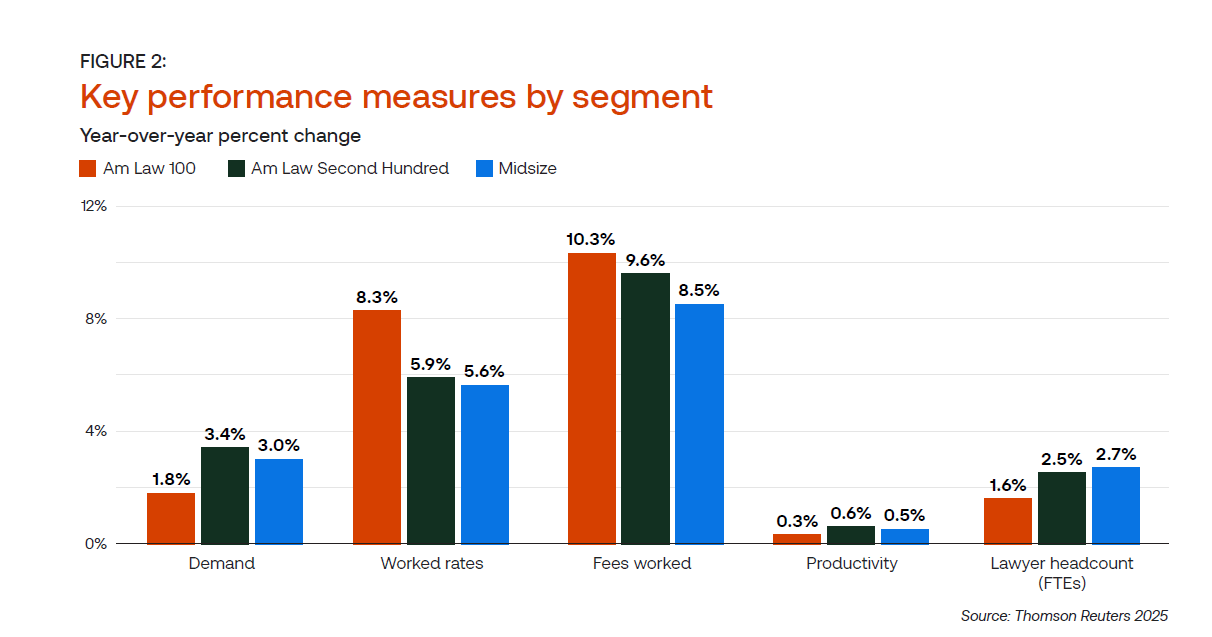Midsize law firms occupy a unique position in the legal market, offering a marked cost advantage over larger firms but sacrificing some of the benefits of scale that larger firms enjoy; however, as technology advances, midsize firms have the opportunity to compete on a new level against larger firms, but they also risk losing some of their existing price advantages
As we step into 2025, midsize law firms in the United States are enjoying a significant moment in the spotlight. A new report from the Thomson Reuters Institute, Midsize law firms at the start of 2025, highlights the current state of midsize law firms, highlighting their successes, challenges, and the evolving legal landscape. However, even as midsize law firms enjoy the benefits of another strong year in 2024, broader market forces are giving them no room to rest on their success.
Midsize law firms have experienced a prolonged period of growth, particularly in terms of demand for legal services. Year-end results from 2024 show that midsize firms are near the forefront of demand growth among all segments of law firms tracked by the Thomson Reuters Institute, a showing of strength in law firm key performance indicators (KPIs).
Another positive KPI is the continued growth of law firm productivity, which has continued to grow despite a 2.7% increase in headcount for the average midsize law firm over 2024. This is a notable achievement, given the nearly 15-year trend of declining productivity in the overall legal market.

Balancing rate growth and cost advantage
Midsize law firms are in the somewhat precarious position of needing to balance increasing their hourly rates to optimize revenue potential while simultaneously maintaining a cost advantage over larger peers. While midsize firms have been more aggressive in growing their rates compared to historical standards, it is notable that they have not pushed as hard as their competitors. While the more cautious approach has allowed them to maintain a cost advantage, it also means they might be missing opportunities for even stronger rate growth. As the report suggests, midsize firms should become more comfortable advocating for their higher billing rates. In fact, many midsize law firms have even gone so far as to implement tiered-rate structures to capture more value from new clients or new work from existing clients.
Further, the report shows that midsize law firms face challenges related to rising expenses. These increased expenditures, coupled with slower-than-market-average growth in rates, have somewhat offset the benefits of strong demand growth for many midsize law firms and placed a bit of a damper on their overall profitability. The average midsize firm has seen an increase in overhead expenses, with technology and knowledge management being key cost drivers. While these investments are crucial for long-term success, they have cut into profit growth. However, as the report emphasizes, these kinds of investments are also critical for firms that want to avoid falling behind larger firms that are leveraging advanced AI-driven tools to enhance their service offerings.
Indeed, innovation is a recurring theme in the report. Larger law firms have dedicated teams driving innovation in both internal processes and client-facing functions. Midsize firms, on the other hand, need to explore emerging technologies and find ways to incorporate them into their operations. Relying on outdated ways of working could put midsize firms at a disadvantage, especially as larger firms use technology to create more appealing and affordable service offerings.
Clearly, AI and technology are transforming the legal market, and midsize firms must keep pace with these changes. Corporate general counsel are increasingly looking to be early adopters of AI, and law firms that fail to recognize this shift can risk losing client favorability. Midsize firms should start by targeting low-hanging fruit and gradually adopting advanced AI tools to streamline workflows and enhance service delivery.
Conclusion: No time for complacency
Despite their recent successes, midsize law firms cannot afford to rest on their laurels. While they have enjoyed a period of demand strength and heightened productivity, the legal market is evolving rapidly. Larger competitors are moving aggressively towards an AI-driven future, and midsize firms must follow suit to remain competitive. Investing in technology, understanding client needs, and adopting innovative service models will be key to sustaining growth and profitability.
You can download a copy of “Midsize law firms at the start of 2025” by filling out the form below:







